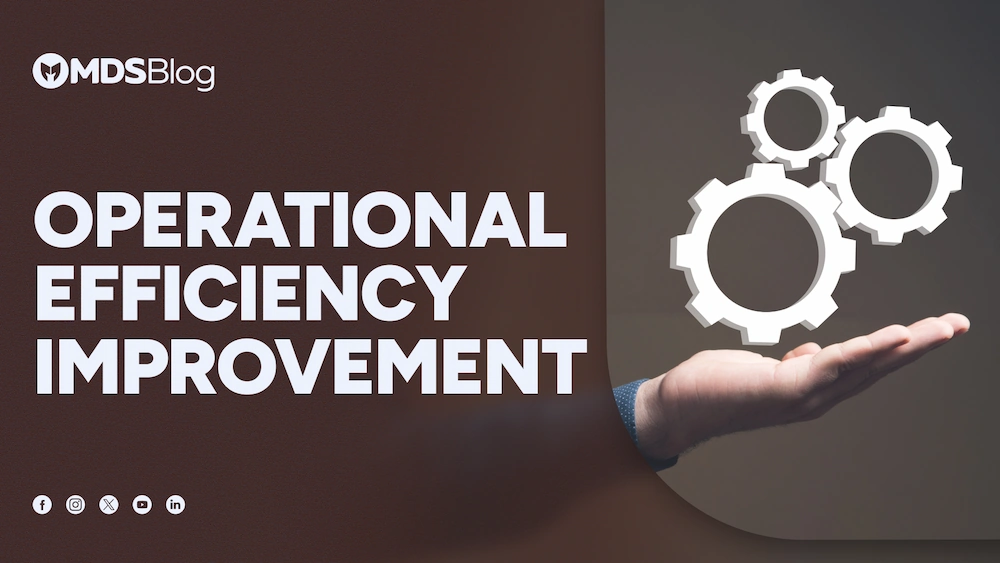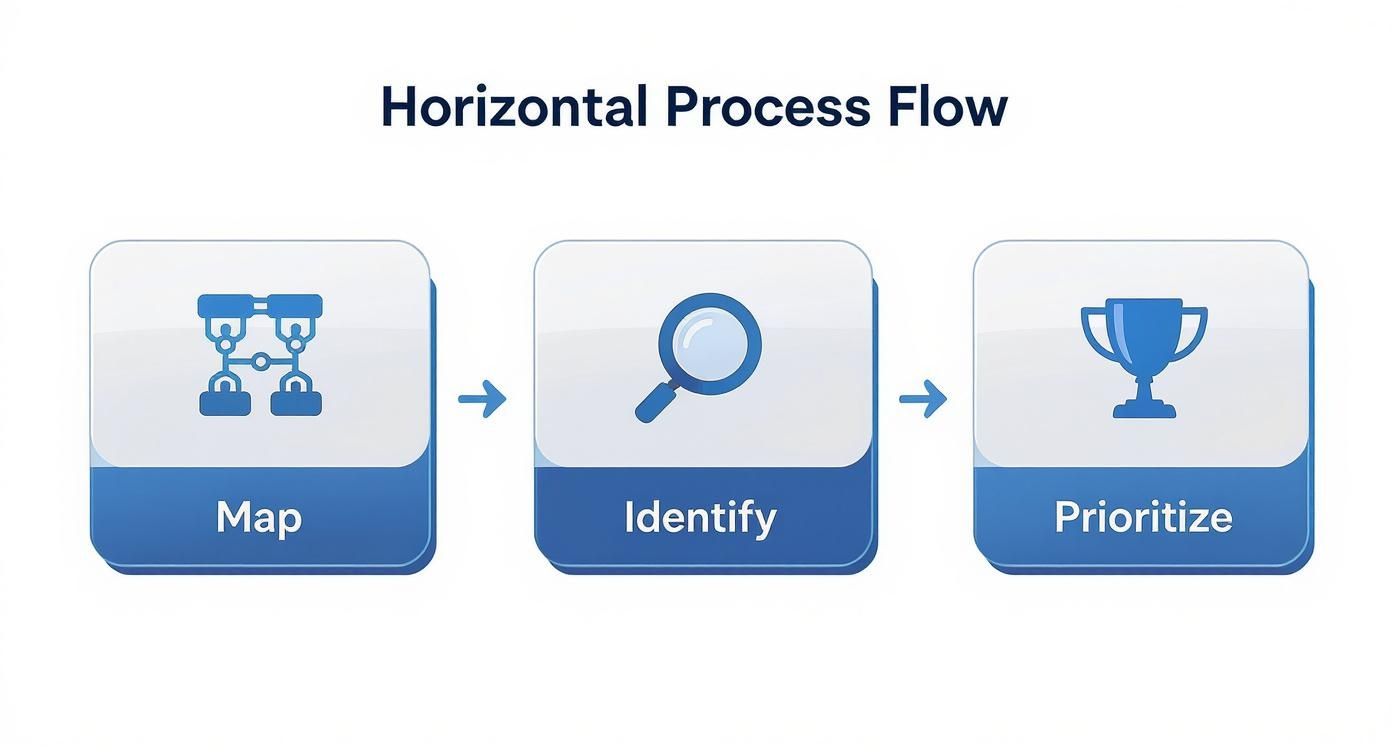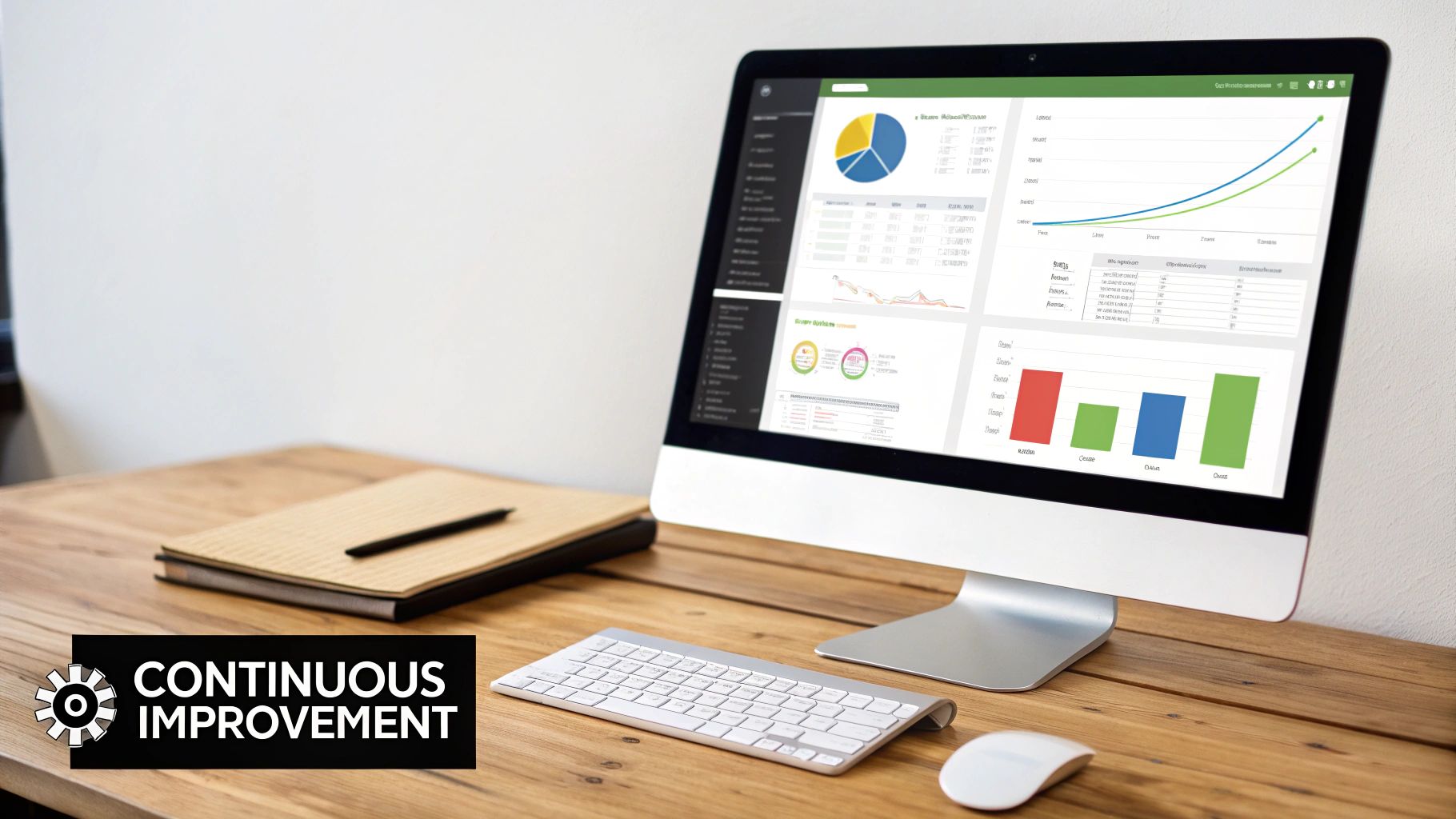Stay Updated with Everything about MDS
Thank you! Your submission has been received!
Oops! Something went wrong while submitting the form.

Chilat Doina
October 26, 2025
Improving your e-commerce business isn't about some secret growth hack. It really boils down to a simple, powerful idea: operational efficiency. This isn’t just jargon for cutting costs; it’s about systematically hunting down and eliminating the friction in your daily workflows. The result? You deliver products faster, cheaper, and with far fewer mistakes.
This whole journey starts with an honest, hard look at how your business actually runs day-to-day.
You can't fix what you can't see. Before you go chasing shiny new software or overhauling entire departments, you have to create a clear map of your current reality. This initial audit is the bedrock of any real improvement, turning guesswork into a data-backed strategy.
It’s all about understanding the complete lifecycle of an order—from the moment a customer clicks "buy" to the package landing on their doorstep. This isn't just a casual walkthrough. It means documenting every single step, noting the tools used, and knowing exactly who is responsible for each action. The goal is to make the invisible visible.
First things first, trace your most important operational paths. Don't try to map everything at once or you'll get bogged down. Just focus on the big ones.
Once you have these paths written down, you'll immediately start to see where the slowdowns and repetitive tasks are hiding. I once worked with an online retailer who discovered their team was losing nearly 20% of their week just manually reconciling inventory reports between their different channels. It was a huge bottleneck they couldn't see until they mapped the process out.
Formalizing these workflows is a critical first step. If you need a framework, our guide on how to create standard operating procedures provides a detailed roadmap for getting this done right.
The infographic below shows the simple but powerful three-stage approach you should take: map, identify, and prioritize.

This flow really drives home that a successful audit isn't just about finding problems. It’s about systematically turning those findings into a concrete, actionable plan for improvement.
To get your audit started on the right foot, you need to know which numbers actually matter. This table breaks down the key metrics you should be tracking from day one.
MetricWhat It MeasuresWhy It Matters for EfficiencyOrder Accuracy RateThe percentage of orders shipped without errors (wrong item, wrong quantity, damage).A low rate points to problems in picking, packing, or inventory data, which create costly returns and unhappy customers.On-Time Shipping RateThe percentage of orders shipped within your stated fulfillment window.Tracks your team's ability to meet customer expectations. Delays often signal bottlenecks in your fulfillment process.Average Time to FulfillThe average time from when an order is placed to when it is shipped.A direct measure of your fulfillment speed. Reducing this time gets products to customers faster and frees up warehouse space.Inventory TurnoverHow many times your entire inventory is sold and replaced over a specific period.High turnover is good; it means you aren't tying up cash in slow-moving stock. Low turnover can indicate poor purchasing or marketing.Cost Per OrderThe total operational cost (labor, supplies, shipping) divided by the number of orders.This is your bottom-line efficiency metric. The goal is to drive this number down without sacrificing quality or speed.Return RateThe percentage of orders returned by customers.High return rates can signal issues with product quality, inaccurate descriptions, or shipping damage, all of which are operational drains.
Tracking these metrics gives you a baseline. It turns vague feelings like "shipping feels slow" into hard data like "our average time to fulfill has increased by 12%," which is something you can actually fix.
With your workflows mapped and your metrics in hand, the friction points will start to jump out. You're looking for tasks that are done by hand but could easily be automated, steps that require waiting for someone else's approval, or processes with consistently high error rates.
A bottleneck is any point in a system where the work arrives faster than it can be processed. In e-commerce, this could be a single person responsible for printing all the shipping labels or a clunky software integration that needs manual data entry every morning.
Now, here’s the key: not all problems are created equal. To avoid getting completely overwhelmed, use a simple impact-effort matrix to prioritize.
Categorize each inefficiency you found based on how much impact fixing it would have versus how much effort it would require. A high-impact, low-effort fix—like automating order tagging in your e-commerce platform—should be at the very top of your to-do list.
This focus on operational excellence isn't just a niche strategy; it’s becoming a global standard. Recent data shows that 42% of organizations now have comprehensive initiatives in place, which tells you that efficiency has to be woven into every level of the business to stay competitive. This data-driven starting point gives you a clear roadmap for the rest of your efficiency journey.

Once your operational audit has put a spotlight on all the hidden friction points, it's time to bring in the bots. And no, I don't mean chasing every shiny new AI tool you see on Twitter. This is about being surgical—applying specific tools to solve the real, costly problems you just spent time uncovering.
Think of it like hiring a team of digital assistants who never sleep or get bored. Their job is to take over the repetitive, rule-based tasks that eat up your team's day. This frees up your people to handle the complex customer issues and strategic growth initiatives that actually move the needle.
The smartest way to start is by targeting high-impact, low-effort tasks. These are the quick wins that build momentum and show everyone, including yourself, the immediate value of automation. Look for processes that are predictable, happen over and over, and don't require a lot of complex decision-making.
Here are a few classic starting points I see e-commerce brands tackle first:
If you’re just getting started, exploring the best marketing automation tools for e-commerce is a great next step. Many of these platforms have the core features you need to get these initial projects off the ground.
Let me give you a concrete example. I worked with an online apparel store that was drowning in returns. The process was a mess of manual steps: a customer would email support, a rep would have to dig up the order, manually approve the return, email a label, and then try to track the incoming shipment. Once it arrived, someone else had to inspect it, restock it, and then process the refund. The whole cycle took days and was riddled with errors.
They implemented a simple returns automation platform, and it completely changed the game. Now, a customer just goes to a portal on their site to start a return. The system automatically verifies the order, generates a shipping label, and notifies the warehouse. When the item gets scanned back into the warehouse, the refund is triggered automatically.
The result? A massive 75% reduction in the time their team spent processing returns. Not only did this free up their customer service reps, but customer satisfaction shot up because the process became so much faster and more transparent.
This is exactly what I mean by targeted efficiency. They didn't try to automate everything at once. They found one high-pain process and knocked it out with a specific solution.
The real magic happens when your different software systems can talk to each other without you playing middleman. The goal is to create an uninterrupted flow of data from your storefront right through to your back-end operations.
Picture this: your Shopify or BigCommerce store, your inventory management system, and your shipping carriers are all connected. An order comes in, and the info automatically flows to your inventory system, which updates stock levels and pings the right warehouse. Once it’s packed, the shipping software generates the label and sends tracking info back to your storefront, which then emails the customer. Boom. No manual data entry, no CSV files.
This kind of connected ecosystem eliminates the manual exports and imports that are a prime source of errors and delays. You don't need a team of developers for this anymore, either. Low-code platforms like Zapier or Make are fantastic for building these bridges between your different apps. And for a deeper look at this, check out our guide on the top AI tools for e-commerce that can help build these intelligent connections.
Brands that get this right see a huge impact. By automating these predictable, rule-based workflows, some have cut their operational drag by as much as 30%. That's a massive amount of time and energy freed up for work that actually grows the business.

Getting your operations humming isn’t a one-and-done project. Think of it more as a continuous cycle of watching, learning, and tweaking. The real secret to lasting success is building a culture that’s never satisfied with "good enough" and is always looking at the data for what's next.
This is how you shift from being reactive—fixing problems only after they’ve already cost you money or a customer—to being proactive. You start spotting the small dips and negative trends long before they snowball into major issues. And it all starts with making your most important numbers impossible to ignore.
Those key performance indicators (KPIs) you nailed down during your audit? They need to become your new best friends. But they’re completely useless if they’re buried in some spreadsheet that only gets opened once a quarter. The first move is to build a simple, visual dashboard that puts these critical metrics right in front of you and your team.
This doesn't have to be some complex, expensive business intelligence tool. You can get started with free or cheap platforms like Looker Studio (formerly Google Data Studio) or even a well-organized spreadsheet that automatically pulls data from your different systems. The point is to see your business’s vital signs at a glance.
Your dashboard should be shouting these core metrics at you:
When these numbers are updated daily or weekly, they become the single source of truth for your whole team. There's no more guessing. Everyone can see exactly how their piece of the puzzle impacts the business's health. This kind of clarity is the foundation for solid data-driven decision making.
Once the dashboard is up and running, the real work starts. Data is just noise until you interpret it. You have to put on your detective hat and look for the clues that point to a bigger story.
For instance, maybe you notice your Cost Per Order has crept up by 8% over the last two months. That’s a signal. Now you dig in. Is it because the cost of bubble mailers went up? Or is your team’s pick-and-pack time getting slower, driving up labor costs?
Here’s a real-world story: One store I worked with dug into its shipping data and found that one of its carriers was a disaster in a few specific regions. Delivery times were a whopping 40% longer than what was promised. Armed with that hard data, they went back to the carrier, renegotiated their contract, and shifted a bunch of volume to a more reliable partner. Almost overnight, delivery times and customer satisfaction in those areas shot up.
That’s the power of turning numbers into a narrative. It’s not about pointing fingers; it’s about finding a crack in the system and sealing it with a smart, targeted fix.
The last piece of this puzzle—and maybe the most important—is getting your team involved. The people on the front lines, packing boxes and talking to customers, see the tiny inefficiencies every single day that you’d never spot from a spreadsheet. You need a system for them to bring those ideas to the table.
This can be as simple as a weekly huddle where you review the dashboard and brainstorm improvements. Or maybe it’s a dedicated Slack channel for suggestions. When someone has an idea, empower them to test it on a small scale.
Let's say a packer thinks organizing shipping boxes differently could speed things up. Great. Let them try it at their station for a week. Track their packing speed and accuracy, and compare it to the old way. If the numbers show a clear improvement, you roll it out to the whole team. This gives everyone a sense of ownership and makes improving efficiency part of everyone’s job.

You can have the most advanced automation software and the most perfectly mapped-out processes in the world, but they mean absolutely nothing if your team isn't on board. Real gains in operational efficiency are just as much about people as they are about technology.
Trust me, investing in new tools without investing in your team is a surefire way to waste money and burn everyone out.
This is the final piece of the puzzle, and it's all about the human side of change. It's about handling the transition carefully, communicating clearly, and turning your employees into partners who are actively building a better, more efficient business with you.
The number one mistake I see businesses make is just dropping a new tool on their team with little to no explanation. The immediate reaction? Resistance. People see it as just another thing to learn or, worse, another way for management to track their every move.
You have to get ahead of that by clearly communicating the why.
Don't just say, "We're implementing a new inventory system." Frame it around the direct benefits to them. Try something like, "We're bringing in a new inventory tool that should completely eliminate manual stock counts. Our goal is to save each of you about five hours of tedious data entry every single week."
When people understand how a change makes their own workday less frustrating, they're far more likely to get on board.
The best way to get people to adopt new tech is to connect operational improvements directly to their day-to-day experience. It’s not about the software; it’s about making their jobs better.
Another incredibly powerful strategy is to involve your team in the selection process right from the start. The people who will be using a tool every single day have a unique perspective—they'll spot potential headaches and benefits that you might completely miss.
Before you even start looking at software, sit down with the relevant team members. Ask them about their biggest daily frustrations and what a perfect solution would do for them. Once you have a shortlist of options, let them sit in on the demos and give their honest feedback.
This simple act of inclusion does two crucial things:
This shared responsibility is the bedrock of a culture that’s committed to continuous improvement. It shifts the entire dynamic from top-down mandates to collaborative problem-solving.
To truly empower your team, you need to give them the right information at the right time. That means taking complex data and making it simple, accessible, and actionable for your frontline staff.
An inventory manager doesn't need a 50-page report. They need to know which three products are at risk of selling out today.
This is where modern tools can really shine. Some companies are now using AI-driven insights to give staff real-time recommendations. This approach takes the mystery out of complex tech and puts its power directly into the hands of the people doing the work.
For example, one mining company saw a massive efficiency boost by making its AI algorithms transparent and accessible to workers at all levels. This built confidence and allowed frontline teams to make smarter adjustments on the fly. You can read more about how organizational design impacts AI adoption in this McKinsey article.
By focusing on clear communication, involving your team, and making data genuinely useful, you create an environment where technology empowers people instead of overwhelming them. This human-centric approach is what makes operational improvements actually stick.
After all the hard work auditing, automating, and getting your team on board, you’re left with the million-dollar question: Did it actually work?
Figuring this out is more than just a pat on the back. It’s how you prove the value of what you’ve done, justify spending more time and money on the next fix, and turn a one-off project into the way you do business from now on.
To really measure the ROI of any operational tweak, you need to tell the whole story. That means digging into the hard numbers, but also highlighting the "softer" wins that have a very real impact on your bottom line.
Let's start with the easy part: the quantitative wins. These are the black-and-white metrics you can pull directly from your initial audit to create a clear "before and after" snapshot.
These numbers are the foundation of your business case. But don't stop there. The qualitative wins are often where the real magic happens.
While hard data proves efficiency, qualitative feedback proves your business is healthier. Improvements in morale and customer sentiment are leading indicators of long-term, sustainable growth.
Think about things like higher employee morale because you finally got rid of a frustrating, soul-crushing manual task. Or maybe you've seen a spike in positive customer reviews that specifically call out your lightning-fast shipping. These things are harder to cram into a spreadsheet, but they directly lead to lower employee turnover and higher customer lifetime value.
A win in one area should be the fuel for a win in the next. The trick is to stop trying to fix everything at once.
The most effective strategy I've seen is to pick one process, nail it, prove its value, and then use that success as a template to tackle the next biggest headache. This methodical, one-two punch approach is what makes improvements stick.
It creates a powerful feedback loop. You find a bottleneck, implement a solution, and measure the results. That success gives you the capital—both financial and political—to go after the next opportunity. This is how you build lasting operational efficiency improvement across your entire business.
To scale your wins, you need a repeatable game plan. Don't reinvent the wheel every single time you want to optimize a workflow.
Following a structured approach like this transforms operational improvement from a random series of projects into a core part of how your business runs. It’s how you ensure every efficiency gain stacks up, contributing to long-term profitability and building a much stronger, more resilient e-commerce operation.
As an e-commerce owner, you're constantly pulled in a million directions. The idea of overhauling your operations can feel overwhelming, especially when you're dealing with tight budgets or a team that’s stuck in its ways. Let's tackle some of the most common questions that pop up when it's time to get serious about efficiency.
Think of this as a practical, no-fluff guide to navigating the real-world challenges you're likely to face.
This is the big one, and the answer is refreshingly simple: start with what you already have. The biggest initial wins in operational efficiency don't come from a pricey new software subscription; they come from sharpening your existing processes.
Kick things off by mapping out a critical workflow, like your order fulfillment process. You don't need fancy software—a whiteboard or a simple spreadsheet will do the trick. Just by observing and writing down every single step, from printing the label to taping the box, you’ll immediately spot opportunities for no-cost improvements. Maybe you can rearrange a packing station to cut down on wasted steps or clarify a confusing part of your returns policy. These small tweaks add up fast.
The most powerful tool for initial improvement isn't a new app; it's a critical eye on your existing processes. Focus on eliminating wasted steps and clarifying communication before you ever consider a software subscription.
Once you’ve grabbed that low-hanging fruit, you can explore low-cost automation. A tool like Zapier has free or inexpensive plans that can connect the apps you're already using. You could set up a simple "zap" that automatically adds a new order to a spreadsheet, saving someone a few minutes of manual entry every single time. The key is to start small, prove the value on a tiny scale, and then reinvest those savings into bigger efficiency projects.
Here's the truth: nobody likes being told they have to change how they work. The secret to getting your team’s buy-in is to make them part of the solution, not just people on the receiving end of a new rule.
You have to frame the change around how it makes their lives easier. Instead of announcing, "We need to be more efficient," try something like, "I want to find a way to get rid of that frustrating manual data entry you all hate doing every morning." See the difference? You’ve shifted the focus from a top-down mandate to a collaborative mission to solve a shared headache.
Get them involved right from the very beginning:
When you do this, you turn skepticism into ownership. Once your team feels heard and sees that the changes are actually making their jobs better, they'll become your biggest champions for improvement.
It’s completely normal to want immediate results, but improving operations is a marathon, not a sprint. Your timeline depends entirely on the scale of the changes you're making.
You can see the impact of small process fixes almost instantly. For example, if you reorganize your shipping station today, you could see a measurable bump in orders packed per hour by tomorrow. Automating a simple task might free up a few hours of manual work within the first week.
Bigger projects, like rolling out a whole new inventory management system, are a different story. You might spend a month on research and setup, another month on training, and you might not see the full financial benefit until a full quarter has passed. Setting realistic expectations is everything. Focus on tracking the small, incremental wins along the way—it keeps momentum going and proves to you and your team that you're heading in the right direction.
At Million Dollar Sellers, we connect you with a network of elite e-commerce founders who have already navigated these challenges. Join our exclusive community to access the strategies and peer support you need to scale your operations intelligently. Learn more at https://milliondollarsellers.com.
Join the Ecom Entrepreneur Community for Vetted 7-9 Figure Ecommerce Founders
Learn MoreYou may also like:
Learn more about our special events!
Check Events